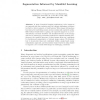Free Online Productivity Tools
i2Speak
i2Symbol
i2OCR
iTex2Img
iWeb2Print
iWeb2Shot
i2Type
iPdf2Split
iPdf2Merge
i2Bopomofo
i2Arabic
i2Style
i2Image
i2PDF
iLatex2Rtf
Sci2ools
112
Voted
EMMCVPR
2005
Springer
2005
Springer
Segmentation Informed by Manifold Learning
In many biomedical imaging applications, video sequences are captured with low resolution and low contrast challenging conditions in which to detect, segment, or track features. When image deformations have just a few underlying causes, such as continuously captured cardiac MRI without breath-holds or gating, the captured images lie on a lowdimensional, non-linear manifold. The manifold structure of such image sets can be extracted by automated methods for manifold learning. Furthermore, the manifold structure of these images offers new constraints for tracking and segmentation of relevant image regions. We illustrate how to incorporate these new constraints within a snake-based energy minimization approach, and demonstrate improvements in using snakes to segment a set of cardiac MRI images in challenging conditions.
Related Content
| Added | 27 Jun 2010 |
| Updated | 27 Jun 2010 |
| Type | Conference |
| Year | 2005 |
| Where | EMMCVPR |
| Authors | Qilong Zhang, Richard Souvenir, Robert Pless |
Comments (0)

